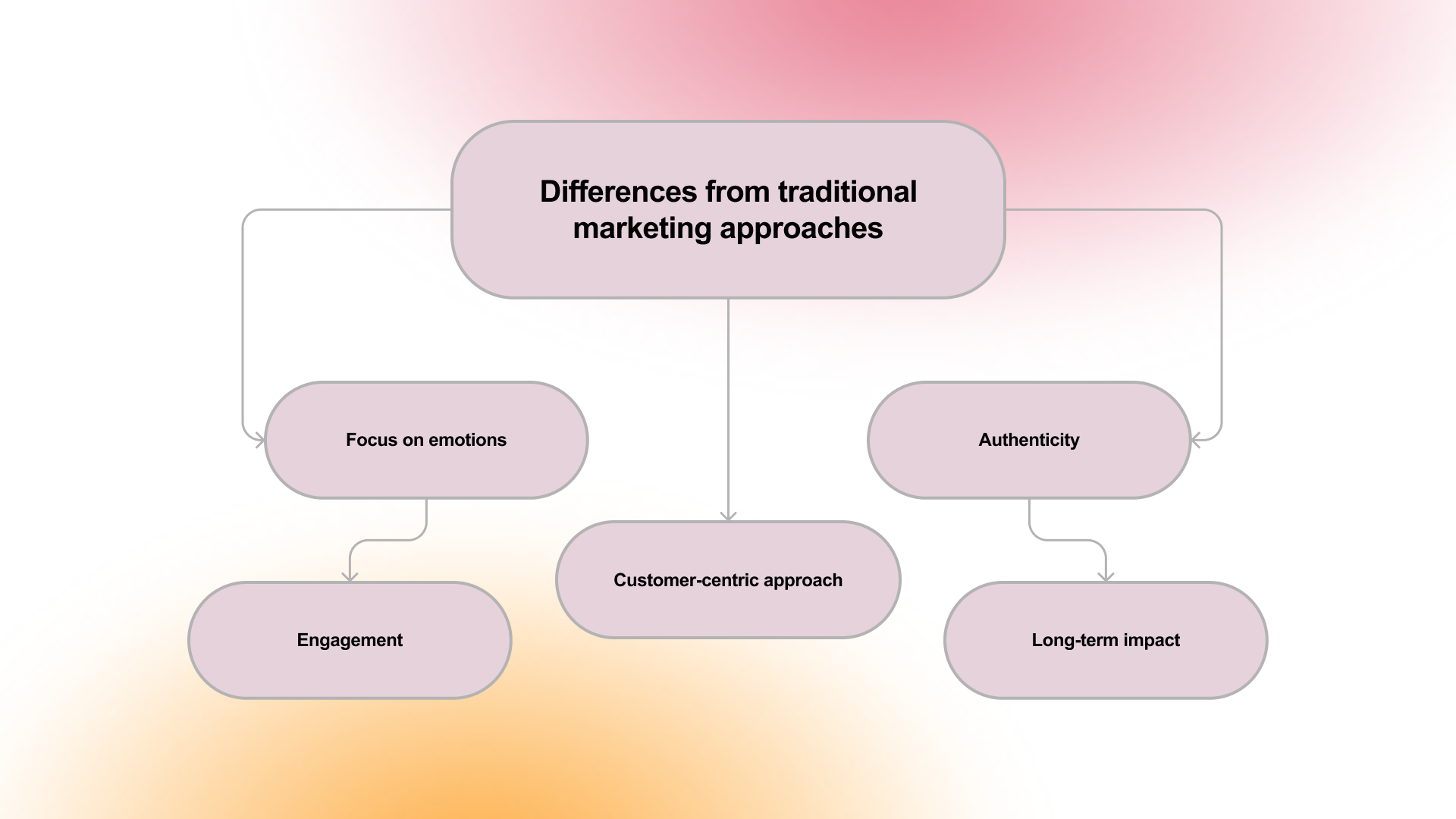What is storytelling in marketing?
Storytelling in marketing refers to the use of narratives to communicate a brand's message, values, or product benefits to its target audience. It involves crafting stories that resonate with consumers and help them connect with the brand on a deeper emotional level.
Content marketing storytelling is a way of engaging with the audience and creating a memorable experience that can be associated with the brand. It is a more authentic and relatable approach to marketing than traditional advertising methods and can help build a loyal customer base.
Successful storytelling in marketing involves understanding the audience's needs and interests and using those insights to craft narratives that are meaningful, relevant, and impactful.
How storytelling differs from traditional marketing approaches?

In contrast to traditional marketing approaches, storytelling involves creating a narrative around the brand or product. Here are several ways in which storytelling differs from traditional marketing approaches:
• Focus on emotions: Traditional marketing often focuses on product features, benefits, and price. Storytelling in marketing, on the other hand, is more focused on creating an emotional connection with the audience through narratives.
• Customer-centric approach: Content marketing storytelling is customer-centric, meaning that the stories are created with the audience in mind. Traditional marketing tends to be more product-centric and less focused on the needs and desires of the audience.
• Authenticity: Storytelling in marketing involves telling real stories about the brand, its customers, or its employees, which can help build trust and credibility.
• Engagement: Storytelling allows the audience to be a part of the story, creating a more memorable and impactful experience.
• Long-term impact: Storytelling has a long-term impact on the audience, as it creates a connection that goes beyond a single product or campaign. Traditional marketing, on the other hand, tends to be more short-term and focused on immediate sales.
Examples of successful marketing campaigns that use storytelling
These campaigns are just a few storytelling marketing examples of how storytelling can be used to create an emotional connection with the audience and promote a brand's message or values.
• Apple's "Think Different" campaign: Apple's famous campaign in the late 1990s featured a series of ads that celebrated creative thinkers and innovators, such as Albert Einstein, Mahatma Gandhi, and Martin Luther King Jr. The campaign used storytelling to position Apple as a company that values creativity, innovation, and individuality.

• Coca-Cola's "Share a Coke" campaign: Coca-Cola's campaign featured personalized bottles and cans with people's names on them. The campaign encouraged people to share a Coke with friends and family, and the stories that emerged from those shared moments helped create a sense of community around the brand.
• Nike's "Just Do It" campaign: Nike's iconic campaign featured ads that told stories of athletes pushing themselves to the limit and overcoming obstacles to achieve their goals. The campaign used storytelling to inspire people to pursue their own dreams and goals.
• Dove's "Real Beauty" campaign: Dove's campaign featured ads that celebrated the beauty of real women, rather than the unrealistic beauty standards often portrayed in the media. The campaign used storytelling to promote a more inclusive and positive message around beauty.
• Airbnb's "Belong Anywhere" campaign: Airbnb's campaign featured ads that told stories of travelers experiencing new cultures and connecting with locals through their Airbnb stays. The campaign used storytelling to promote the idea that Airbnb is more than just a place to stay, but a way to connect with the world.
Why is storytelling so effective in marketing?
Concluding from the storytelling marketing examples above, storytelling is effective because it taps into several psychological principles that influence how people think, feel, and behave. There are 5 main principles:
• Emotional engagement: When people feel emotionally invested in a story, they are more likely to remember it and share it with others.
• Personal relevance: When people see themselves reflected in a story, they are more likely to connect with it on a deeper level.
• Social influence: Stories that are shared by others, such as friends, family, or social media influencers, are more likely to be trusted and believed. When people see that others have enjoyed a story or found it helpful, they are more likely to engage with it themselves.
• Cognitive processing: Stories are processed differently in the brain than facts or statistics. They activate multiple regions of the brain, including those involved in sensory processing, emotion, and memory. This makes them more impactful than other types of information.
• Identification: When people identify with the protagonist or the values of a story, they are more likely to adopt those values or behaviors themselves. This can lead to increased brand loyalty and a more positive brand image.

By leveraging these psychological principles, storytelling in marketing can be a powerful tool for creating a deeper connection with the audience.
A step-by-step guide for incorporating storytelling into your marketing strategy
By following these steps, you can effectively incorporate storytelling into your marketing strategy. Remember that storytelling is a process that requires ongoing testing and refinement, so be open to feedback and willing to adapt as needed.
• Define your brand story: What values, beliefs, or mission does your brand embody? How is your brand different from other competitors? Develop a brand narrative that reflects these qualities.
• Identify your target audience: What are their needs, desires, and pain points? How can your brand narrative connect with them on an emotional level?
• Choose your storytelling format: This could be a video, blog post, social media post, or even a podcast. Consider the tone, style, and length of the story, as well as the platform where it will be shared.
• Develop a compelling story: Use storytelling techniques such as character development, conflict, and resolution to create a narrative that captures the audience's attention and emotions.
• Make it authentic: Avoid using cliches or exaggerations that can undermine the audience's trust in your brand.
• Incorporate a call-to-action: This could be visiting your website, subscribing to your newsletter, or purchasing a product.
• Test and refine: Experiment with different formats, platforms, and storytelling techniques to find what works best for your brand and audience.

Different types of narratives that you can use (customer stories, brand stories, origin stories, etc.)
Here are some of the most common types of narratives used in marketing:
• Customer stories: Customer stories are narratives that showcase how your product or service has helped a customer solve a problem or achieve a goal. These stories are powerful because they are relatable and demonstrate the real-world impact of your brand. They can be presented in a variety of formats, such as case studies, testimonials, or user-generated content.
• Brand stories: Brand stories are narratives that articulate the history, values, and mission of your brand. They help to establish your brand's identity and build an emotional connection with your audience. Brand stories can be presented in a variety of formats, such as videos, blog posts, or social media campaigns.
• Origin stories: Origin stories are narratives that explain the origin and evolution of your brand. They help to establish your brand's credibility and uniqueness, and can be particularly effective for startups or brands that are introducing a new product or service to the market. Origin stories can be presented in a variety of formats, such as videos, blog posts, or infographics.
• Product stories: Product stories are narratives that highlight the features, benefits, and unique selling points of your product or service. They help to differentiate your product from competitors and demonstrate its value to the customer. Product stories can be presented in a variety of formats, such as product demos, explainer videos, or social media ads.
• Influencer stories: Influencer stories are narratives that leverage the popularity and credibility of social media influencers to promote your brand or product. They help to reach new audiences and build trust with potential customers. Influencer stories can be presented in a variety of formats, such as sponsored posts, Instagram takeovers, or influencer-led events.
The key is to understand your audience and tailor your content marketing storytelling approach to their needs, interests, and values.
How to structure your narratives for maximum impact?
Structuring your narratives effectively is crucial to maximizing their impact on your audience. Here are some key tips for structuring your narratives for maximum impact:
• Start with a hook: This could be a surprising fact, a provocative statement, or an engaging story.
• Establish the setting and characters: This helps to create a sense of context and empathy, and allows the audience to visualize themselves in the story.
• Create conflict and tension: Identify the key challenges or obstacles that your characters face, and use them to create suspense and drama.
• Provide a resolution: This could be a solution to the problem, a realization or learning, or a happy ending.
• Include a call-to-action: This helps to convert the audience's engagement with the story into tangible results for your brand.
When structuring your narratives, remember to keep them concise and focused on a single message or theme. Avoid tangents or unnecessary details that can distract the audience from the main point of the story.
Common mistakes to avoid when using storytelling in marketing
While storytelling can be a powerful tool in marketing, there are some common mistakes that marketers should avoid when incorporating it into their campaigns. Here are a few of the most common mistakes:
• Forgetting the message: One of the biggest mistakes is getting so caught up in the story that you forget the message or call-to-action. Remember that the story should serve the purpose of communicating your brand's message and driving the audience toward a specific action.
• Being too salesy: The audience is more likely to tune out if they feel like they are being bombarded with a sales pitch. Use storytelling to establish an emotional bond with your clients.
• Not knowing your audience: Not understanding your audience's values, needs, and interests can result in a story that misses the mark. Make sure to do your research and tailor your story to resonate with your specific audience.
• Being too generic: Generic, uninspired stories can fail to capture the audience's attention. Make sure to be creative and original, and use real-world storytelling marketing examples to illustrate the impact of your brand.
• Neglecting visuals: Visuals can help bring your story to life and make it more engaging. Neglecting to use visuals or choosing irrelevant visuals can detract from the impact of your story.
• Overcomplicating the story: A story that is overly complex can be confusing and lose the audience's attention. Keep the story simple and focused on a clear message.
• Failing to measure success: Measuring the success of your story is essential to understanding its impact on the audience and achieving your marketing goals. Neglecting to measure success can result in missed opportunities for improvement.
By avoiding these common mistakes, you can create compelling stories that resonate with your audience, drive engagement, and ultimately contribute to the success of your marketing campaigns.
Examples of brands that have successfully used storytelling to connect with their audience
There are many brands that have effectively used storytelling to connect with their audience. Here are some examples:
• Nike: Nike is known for its powerful storytelling that often focuses on the stories of real athletes and their struggles to overcome challenges. Nike's "Dream Crazy" campaign featuring Colin Kaepernick is a prime example of how the brand used storytelling to connect with its audience by tapping into the cultural conversation around racial injustice and using Kaepernick's personal story to deliver a powerful message.
• Apple: Apple is known for its minimalist storytelling style that emphasizes simplicity and elegance. The brand's "Think Different" campaign featuring famous people like Albert Einstein and Mahatma Gandhi is an example of how Apple used storytelling to create an emotional connection with its audience by celebrating creativity and individuality.
• Coca-Cola: Coca-Cola is known for its heartwarming and inclusive storytelling that often focuses on creating shared moments of happiness. The brand's "Share a Coke" campaign is a prime example of how Coca-Cola used storytelling to connect with its audience by creating a personalized and inclusive experience that brought people together around a shared love for the brand.
• Airbnb: Airbnb is known for its storytelling that focuses on the personal stories of its hosts and guests. The brand's "Belong Anywhere" campaign is an example of how Airbnb used storytelling to create a sense of community and connection between people from different cultures and backgrounds.
• Dove: Dove is known for its storytelling that focuses on real women and their struggles with body image. The brand's "Real Beauty" campaign is an example of how Dove used storytelling to connect with its audience by celebrating diversity and empowering women to feel confident in their own skin.

By focusing on authentic, relatable, and inspiring stories, these brands have been able to create meaningful experiences for their customers and position themselves as leaders in their respective industries.
The key points of the article
Storytelling in marketing involves using narratives to communicate a brand's message, values, or product benefits to its target audience.
Storytelling differs from traditional marketing because it focuses on emotions, has a customer-centric approach, is authentic, fosters engagement, and creates a long-term impact.
Effective storytelling requires understanding the audience's needs and interests and using those insights to craft meaningful narratives.
Successful storytelling marketing examples are campaigns such as Apple's "Think Different," Coca-Cola's "Share a Coke," Nike's "Just Do It," Dove's "Real Beauty," and Airbnb's "Belong Anywhere".
Storytelling is effective because it taps into psychological principles that make it more memorable and gripping.
A step-by-step guide for incorporating storytelling into marketing strategy includes defining the brand story, identifying the target audience, choosing the storytelling format, and measuring the impact.
Sources for the article: Hubspot, Forbes, American Marketing Association, Content Marketing Institute, Harvard Business Review, Entrepreneur, Buffer.
The fastest way to build digital experiences. We empower businesses to convert PDFs, presentations and other content into interactive experiences & webpages with instant branding, analytics & more



